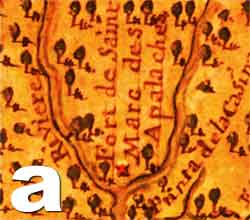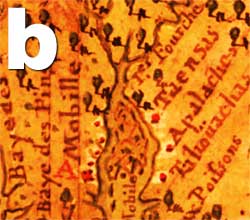The Talimali Band of Apalachee
by Dayna Bowker Lee
The Apalachee before 1763
The Apalachee of northwest Florida [see map area "a"] were among the first indigenous North Americans encountered by European explorers. A strong and powerful chiefdom comprised of dispersed villages and approximately 50,000 people, the Apalachee practiced agriculture and participated in the mound-building Mississippian Tradition that defined the late-prehistoric southeast. Hostile to Spanish explorers and protective of their territory and autonomy, the Apalachee were eventually reduced by sustained conflicts and by the virgin soil diseases introduced by Europeans into the New World.
By the 17th century, the surviving Apalachee were largely converted to Catholicism and were bound to the Spanish mission system. Mission San Luis de Talimali grew up at the former core village of Anhaica and remained the primary Apalachee village and the westernmost Spanish military and religious capital until the early 18th century.
In response to escalating British and allied Creek attacks on the Spanish mission and its dependents, the Apalachee burned their mission village and abandoned it in 1704. Many Apalachee were killed in the conflicts, while others were enslaved and removed from their traditional homeland. A few survivors relocated to the Spanish settlement at St. Augustine, but the majority of the tribe moved west to Mobile in the French colony [see map area "b"]. After France lost its North American territories as a result of the French and Indian War, this group made the long trek to Louisiana and settled in present-day Rapides Parish.

Click on the maps for a larger view.
The Apalachee before 1763 | The Apalachee Village, Rapides Parish | The Kisatchie Hills | Epilogue | Appendices

